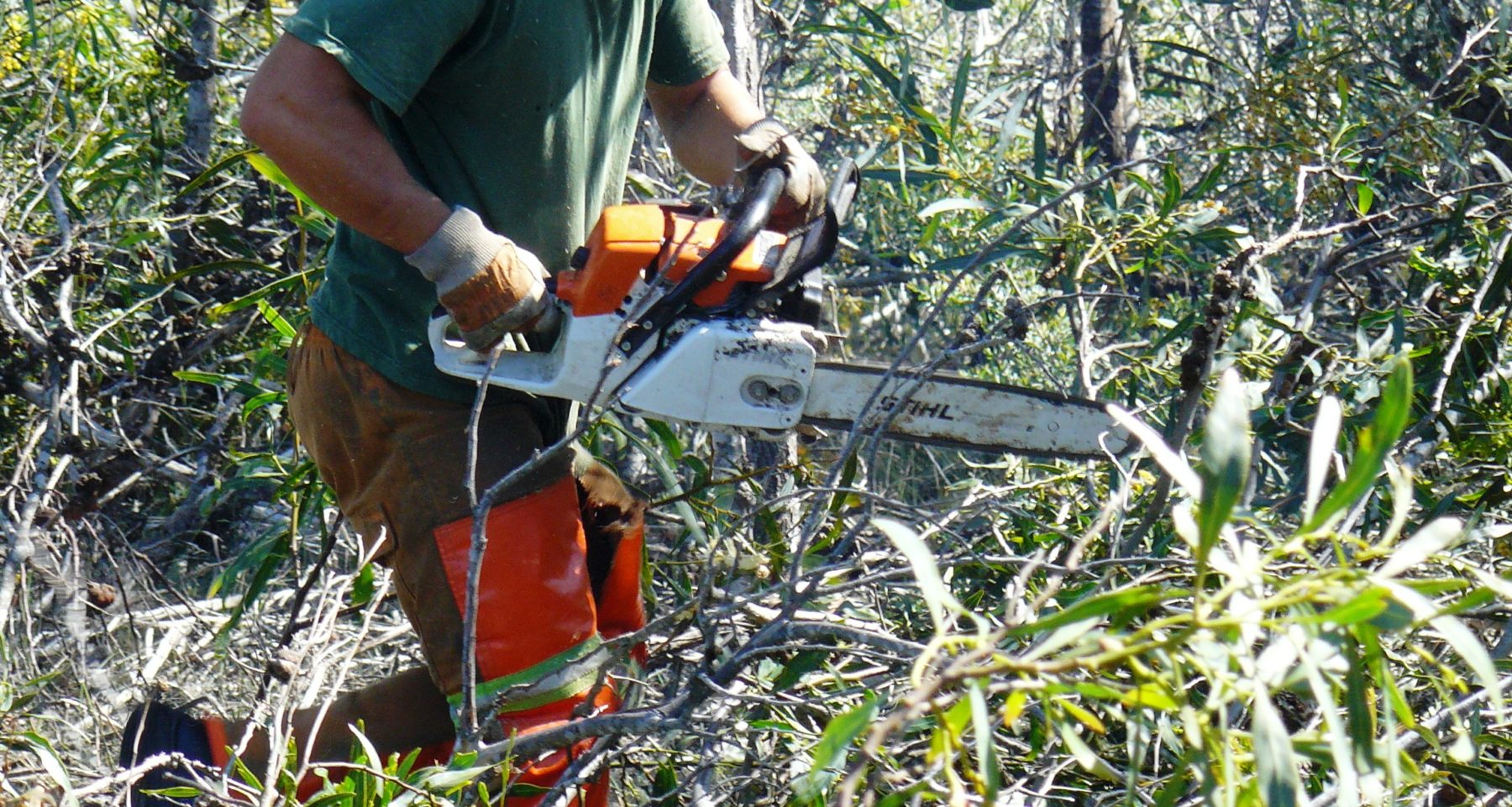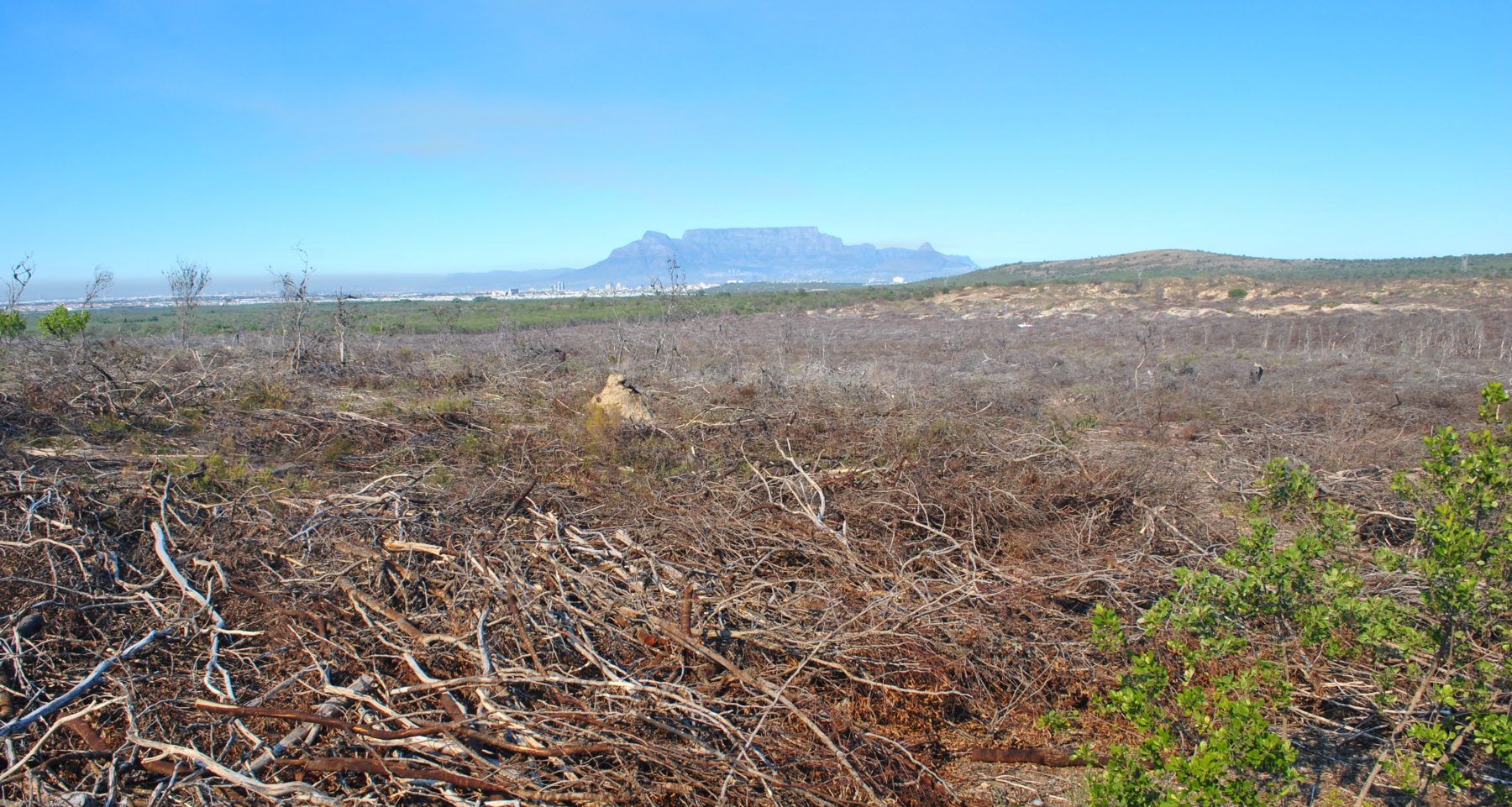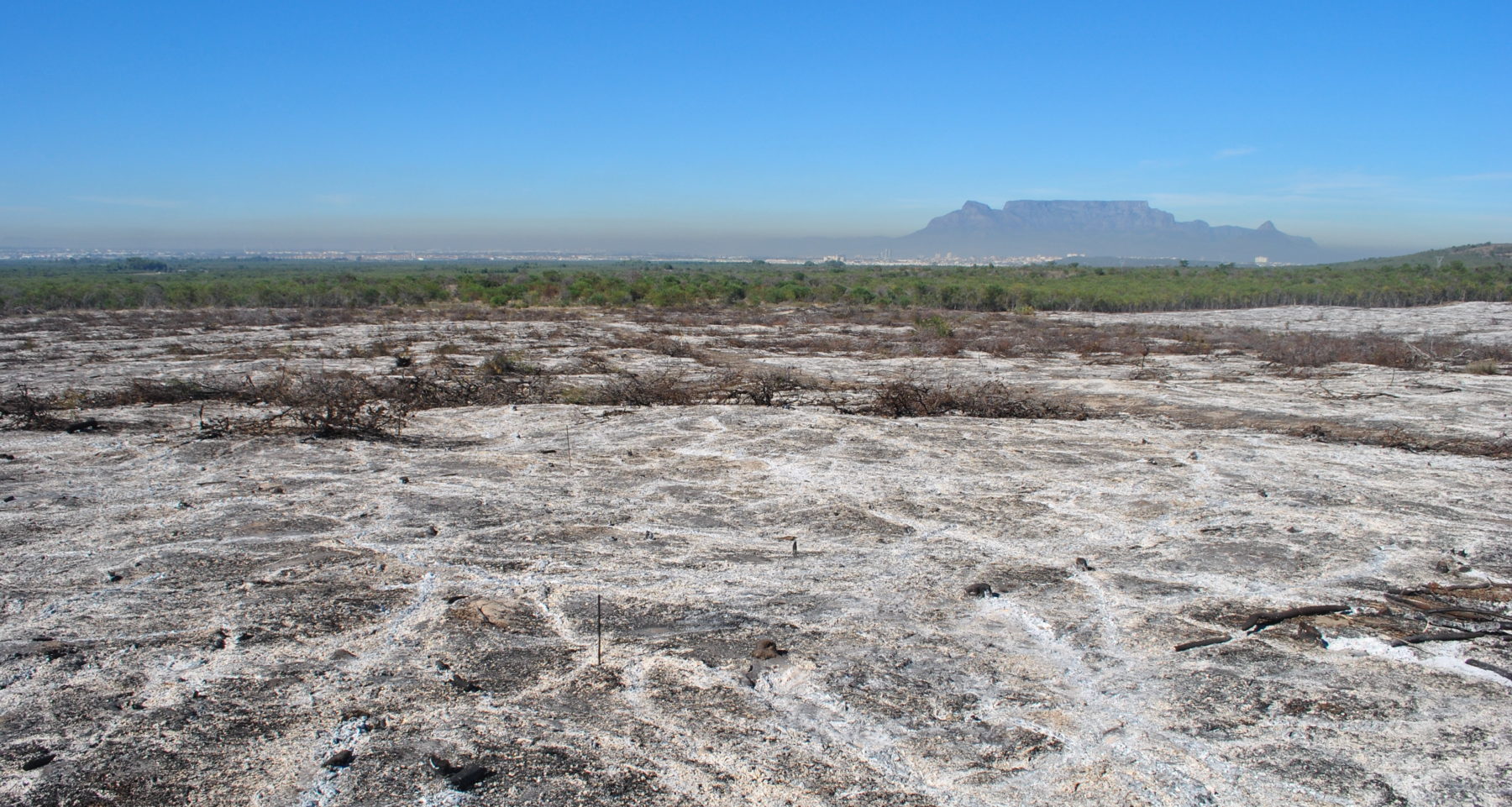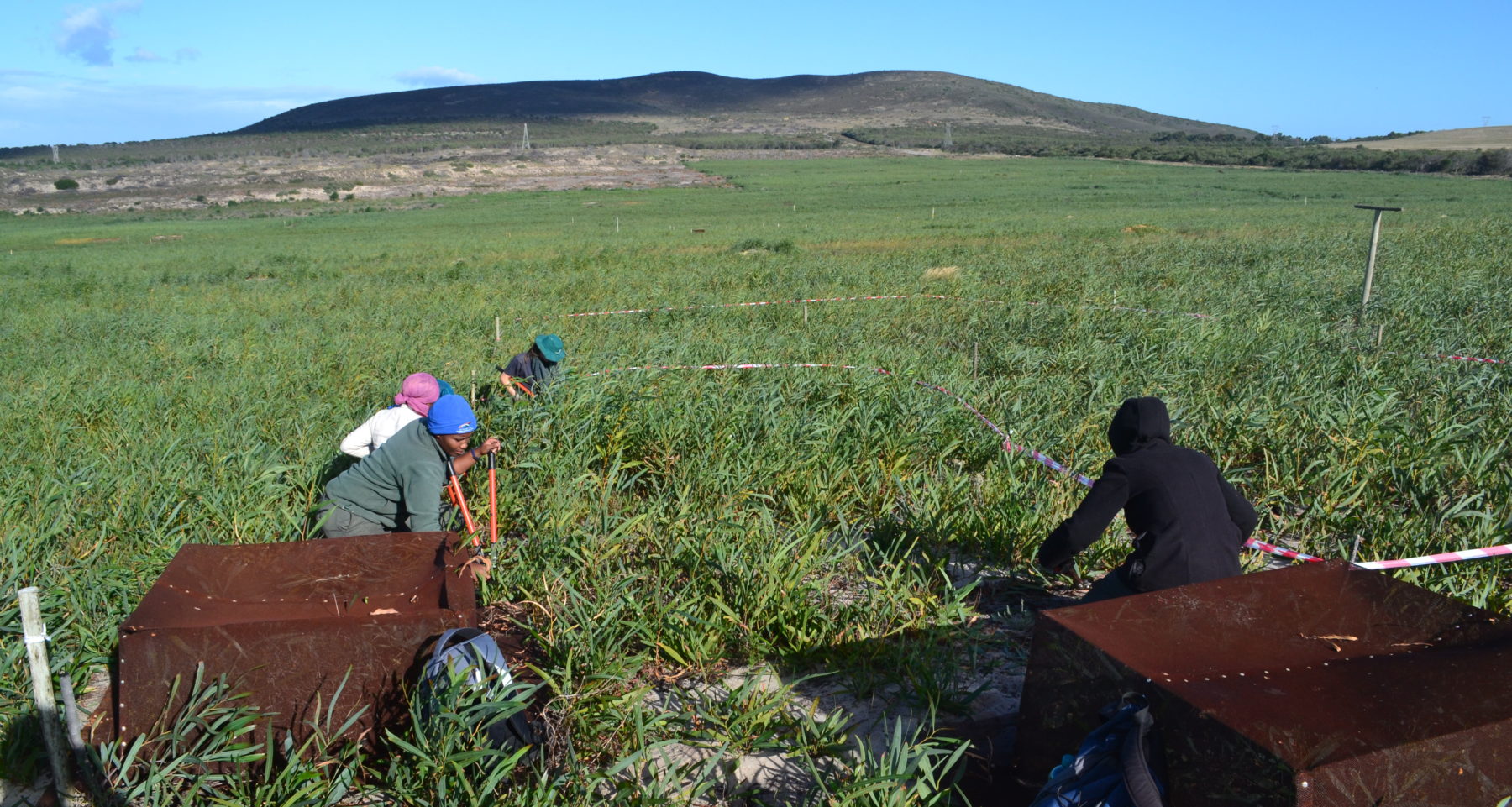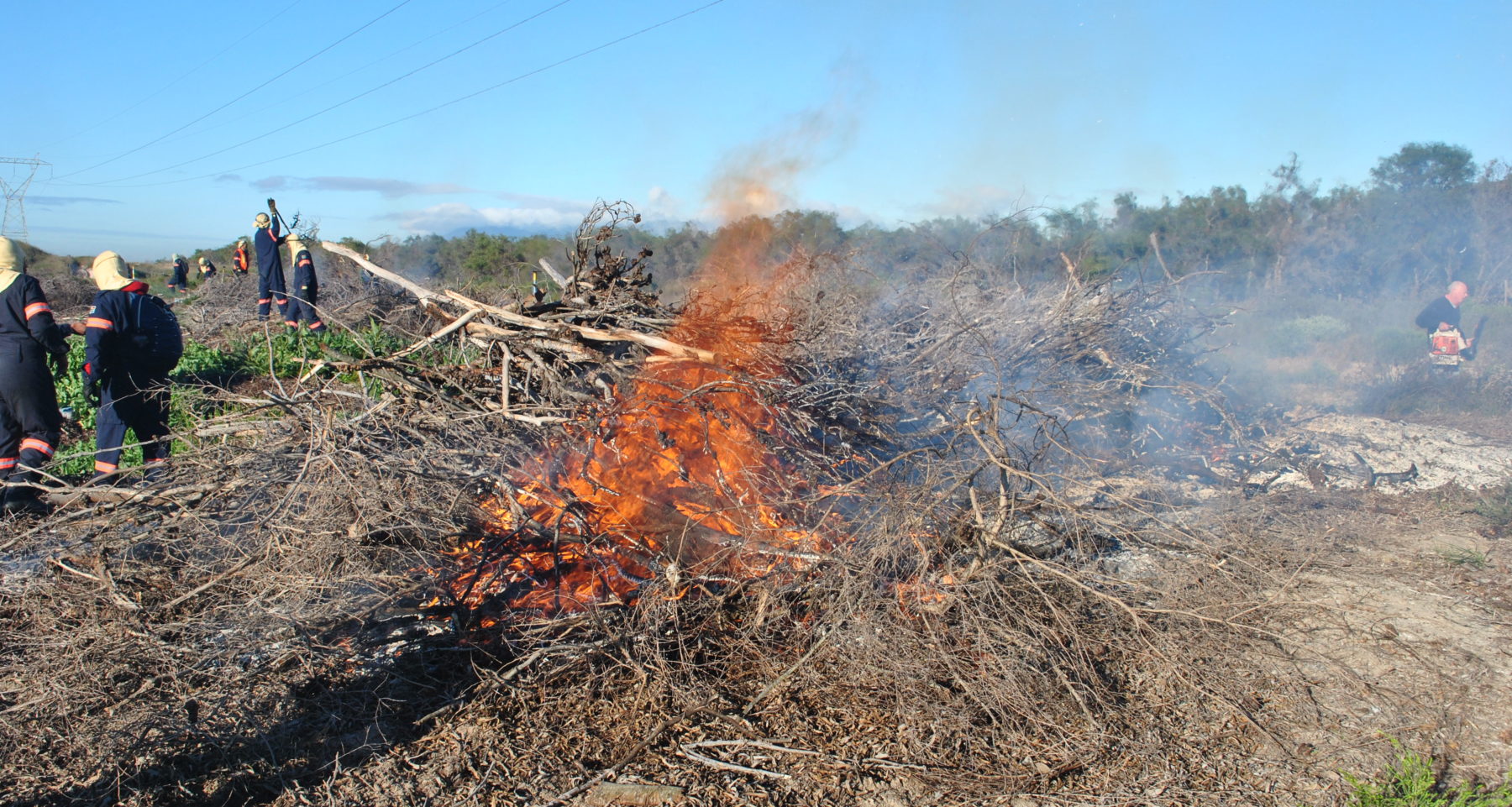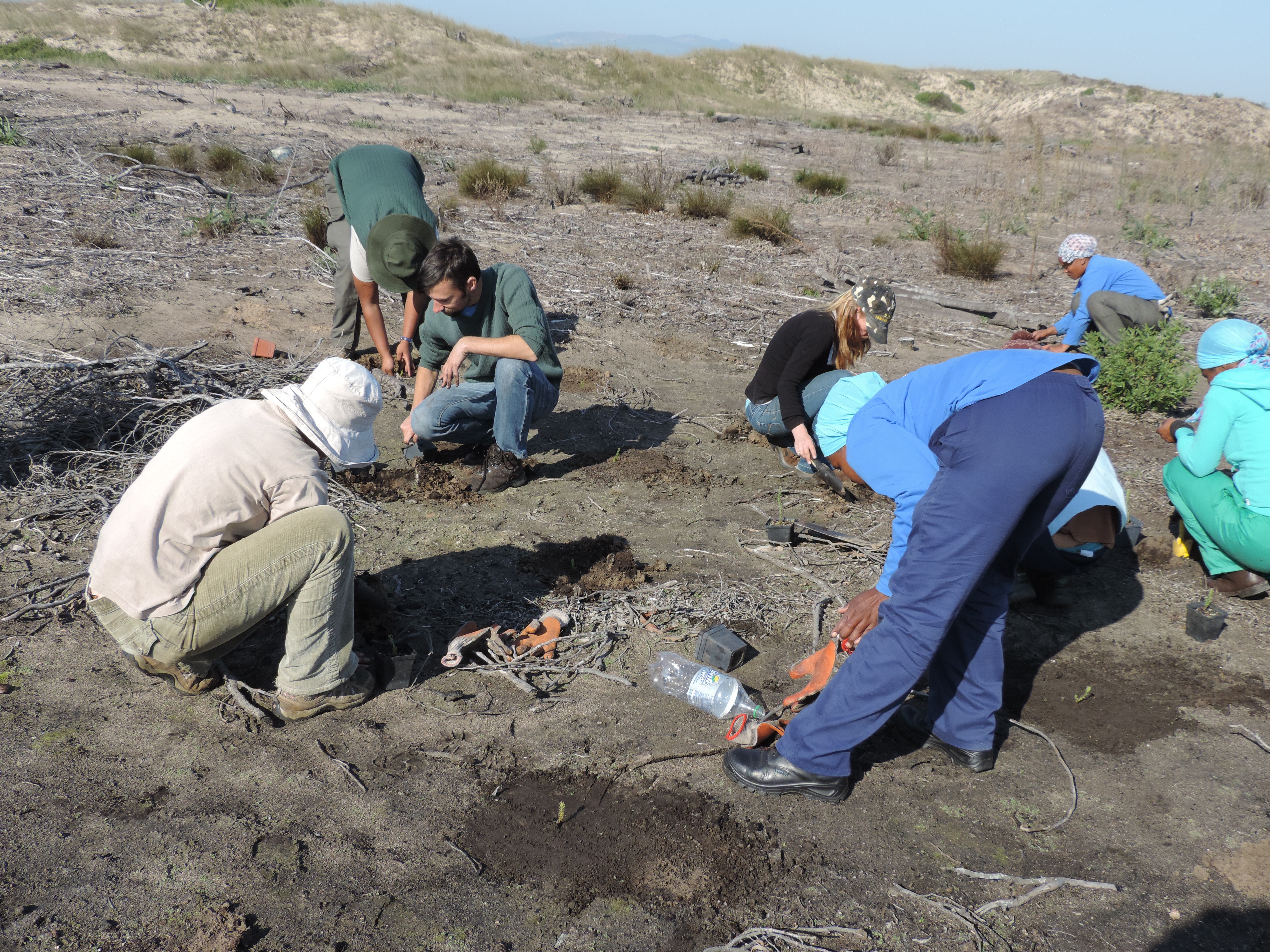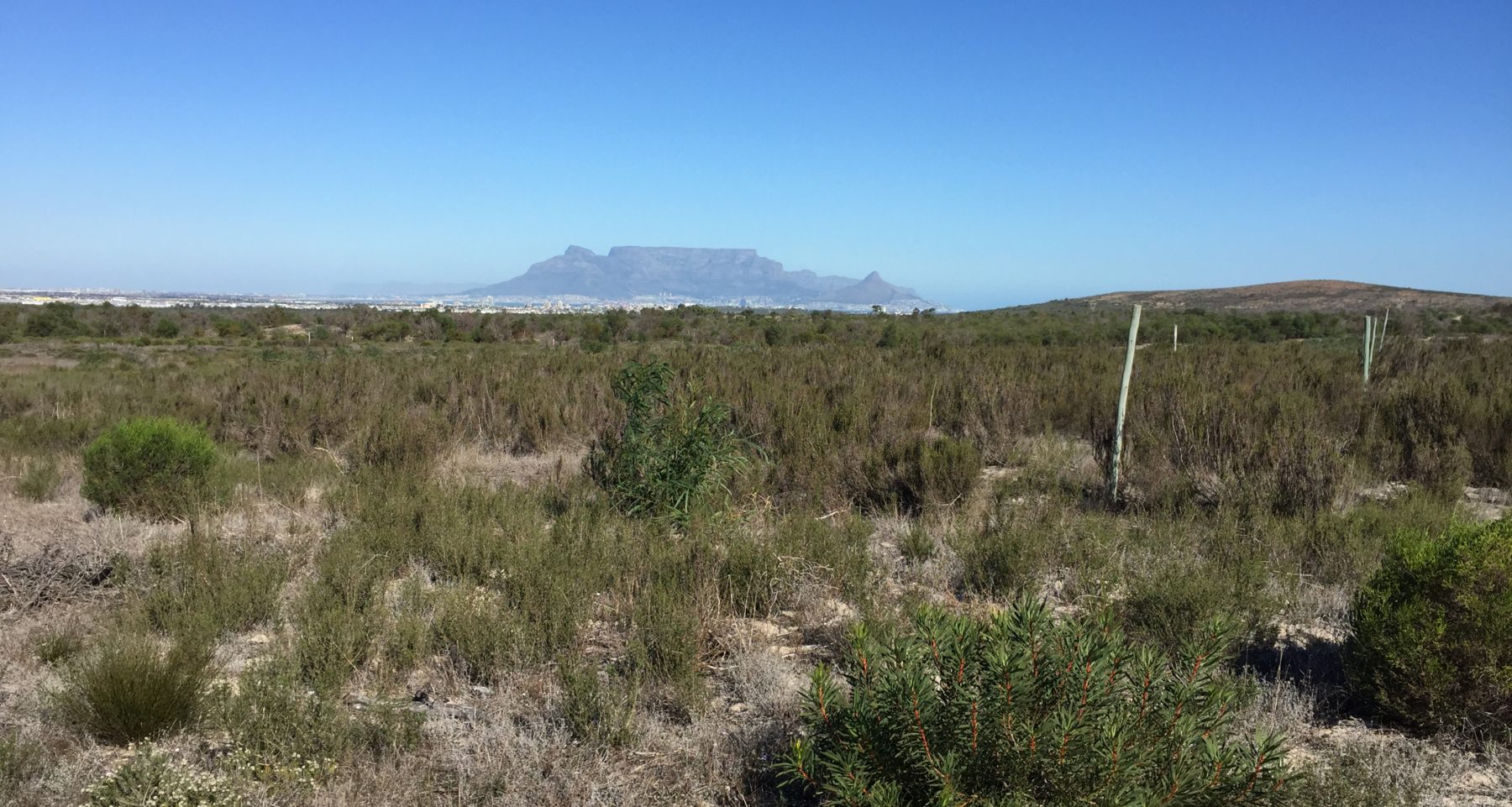Overview
The project addresses restoration of critically endangered Cape Flats Sand Fynbos in Cape Town. In 2012 funding was sourced to clear 96 ha of dense Acacia saligna stands and to investigate optimal restoration approaches while promoting co-learning among stakeholders. 32 ha were cleared using “Fell & Burn” and the remainder by “Fell & Stack” methods. Follow-up control was done annually. Native seed was collected from nearby remnants and some propagation done to reintroduce species into cleared highly degraded areas.
The first two research projects investigated optimal restoration approaches, including seed germination cues and establishment in a range of native species. The collaboration attracted other students who studied small mammals, ants, soil microbiology and nutrients in relation to wattle invasion.
The initial treatments restored some native vegetation cover but not the required vegetation structure and composition. More research is needed to improve establishment of under-represented guilds, such as resprouter ericoid-leaved shrubs. Another limitation is the dearth of native remnants to supply seeds and material for propagation, therefore more efficient ways to establish species from seed and/or rootstock are needed. It is proposed to study seed coating technologies for direct sowing and tubestock for more efficient production in the nursery.
Quick Facts
Project Location:
Cape Town, South Africa, -33.9248685, 18.424055299999964
Geographic Region:
Africa
Country or Territory:
South Africa
Biome:
Temperate Forest
Ecosystem:
Other/Mixed
Area being restored:
400 ha - note above, Biome is Mediterranean-Climate Shrubland
Project Lead:
P Holmes Stellenbosch University Conservation Ecology & Entomology Department and private consultant (Cape Ecological Services)
Organization Type:
University / Academic Institution
Project Partners:
Cape Ecological Services (PM Holmes), City of Cape Town, Biodiversity Management Branch; Stellenbosch University Conservation Ecology & Entomology Department; Kirstenbosch Botanic Gardens Conservation Programme.
Location
Project Stage:
Post-Implementation Maintenance
Start Date:
2012-06
End Date:
2021-12
Primary Causes of Degradation
Invasive Species (native or non-native pests, pathogens or plants)Degradation Description
The Blaauwberg Nature Reserve encompasses 400 ha of critically endangered Cape Flats Sand Fynbos, most of which is highly degraded following long invasion (pre-1950s in some areas) by the Australian wattle, Acacia saligna. Most areas are either devoid of indigenous vegetation under the wattle trees or have very low and sparse indigenous cover. The fynbos shrubland has been replaced by a dense alien woodland with sparse, open understory. Local biodiversity is completely extirpated except in a few scattered remnants that have experienced lower or more recent invasion impacts. Although the sandy soils have never been ploughed, indigenous seed banks are depleted and have been replaced by dense wattle seed banks (8-10,000 seeds/m2). Ecological function has changed: soils in alien stands have elevated total nitrogen concentration owing to the N-fixing capabilities and higher leaf litter inputs by the wattles compared to fynbos shrubland. These stands of wattle have low grazing value but have some limited socio-economic value for informal wood-cutters.
Defining the Reference Ecosystem
The reference ecosystem is primarily based on contemporary reference sites or existing analogues of the pre-degradation ecosystem.Reference Ecosystem Description
Cape Flats Sand Fynbos is a dense, moderately tall, ericoid-leaved shrubland, with scattered emergent tall shrubs, and occurs on undulating to flat sandy plains. The reference community has a proteoid overstory and ericoid shrubs and restioids (graminoids with photosynthetic stems) also are prominent components. Fire in the summer dry season is an important ecosystem driver and many species are obligate reseeders, recruiting from the soil seed bank or canopy-held seed in the winter post-fire. However resprouting perennial species form half of the vegetation cover and are an important structural component. Ephemeral geophytes (dormant in summer) may be prominent post-fire and are an important biodiversity component. Local, less disturbed natural remnants and structurally similar adjacent Sand Fynbos with persisting intact natural habitat (Atlantis Sand Fynbos), were used as reference sites. Vegetation guild structure and soil characteristics in reference communities were used as benchmarks for restoring ecosystem structure and function at the restoration site. To date, we attempted to restore a variety of species in each of the major structural guilds, focusing on the more common species because intact remnants with seed sources are few. Owing to predictions of warmer, drier conditions and more frequent fires under climate change, resprouter shrubs are viewed as a key guild to restore. Restoration success was assessed in the research component of the project by comparing treated plots with reference plots in terms of cover, density and richness of growth forms (including regeneration mode of resprouter or reseeder).
Project Goals
1. To restore degraded Cape Flats Sand Fynbos in the Blaauwberg Nature Reserve.
2. To contribute to the body of research documenting successful and cost-effective alien vegetation control and active restoration methodologies. The proposed future research will investigate technologies to improve establishment of resprouter ericoid shrubs and threatened plant species that do not establish well from direct sowing of pre-treated seeds in the field. This will include testing seed coat technologies and more cost-effective production of rooted material using tubestock/ plug production in the nursery.
3. To provide operational support to enable large-scale ecological restoration and research by clearing stands of invasive alien trees and collecting indigenous seed and propagating cutting material for restoration.
4. To train restoration ecologists at post-graduate level, as well as to train and provide employment for local contract teams in alien clearance and seed collecting methods.
Monitoring
Monitoring Details:
The research component serves as the main monitoring program for restoration of fynbos vegetation. Some of the initial vegetation monitoring plots set up by a post-graduate student in 2012 continue to be monitored by City Biodiversity Management staff. In addition, staff monitor invasive species re-emergence and plan follow-up control in response to this.
Start date, including baseline data collection:
May 2012
End Date:
2021 or later if we are successful in securing additional funds to continue restoration of the 400 ha.
Stakeholders
1. City of Cape Town, Biodiversity Management Branch, including: Conservation Services, Blaauwberg Nature Reserve Management, Invasive Species and Restoration Facility staff, students and interns. When the project was first initiated in 2012, the project coordinator (Patricia Holmes) worked for the Biodiversity Management Branch and initiated many of the partnerships below.
2. Stellenbosch University Conservation Ecology & Entomology Department staff and post-graduate students. Restoration ecology research has been a parallel stream to implementation from the beginning in order to foster co-learning between research and management. So far seven post-graduates (Honours to PhD level) have contributed to the body of knowledge (see Resources section) with another two recently appointed.
3. Stellenbosch University Centre for Invasion Biology in the Biological Sciences Department, supported some of the post-graduate students involved in this restoration ecology research.
4. Kirstenbosch Botanic Gardens Millenium Seed Bank Project and Conservation Programme staff. The Millenium Seed Bank Partnership at Kew Royal Botanic Gardens, UK, provided the initial project funding for two post-graduate research projects in restoration ecology based at Stellenbosch University, in return for new species collections for the seed bank.
5. The Hans Hoheisen Trust has provided funding for the current phase of the project, including the clearance of another 24 ha of alien-invaded fynbos (to be implemented from July 2019) and the associated research component comprising two post-graduate (PhD and MSc) students.
6. Friends of Blaauwberg community volunteers: the reserve has an active community of volunteers, some of whom assist with field work, including alien control and seed collecting activities.
7. Contractors appointed for invasive species clearance and indigenous species seed collection and propagation. The City Biodiversity Management Branch staff ensure that new contractors and their team members receive appropriate training to conduct the work.
In the initial stages of the project (2012-2015), meetings were convened by the project leader separately with the operational staff and research staff and students. The researchers and students regularly presented their research work at university research days and local fora, such as the Fynbos Forum, attended by researchers, conservation managers and other stakeholders. In addition, local project workshops were held for the primary stakeholders to feedback on project progress, discuss challenges and plan for future research and operational requirements.
How this project eliminated existing threats to the ecosystem:
To date 96 ha of alien-invaded fynbos has been cleared, with follow-up clearing conducted annually. In order to conduct restoration research at large scale, 32 ha were cleared using a “Fell and Burn” treatment, with a prescribed burn conducted at the end of the dry season to remove alien biomass, stimulate residual fynbos soil seed banks and prepare a seed bed for sowing. For comparison, 32 ha cleared using a “Fell and Stack” treatment in which burning of stacked slash material was done during winter. The areas outside of these 64 ha research generally had higher ground cover of fynbos under the wattles and were cleared using the “Fell and Stack” method.
How this project reinstated appropriate physical conditions (e.g. hydrology, substrate)",:
The large woody alien biomass was burned to remove the tall woodland vegetation structure as an important first step. The “Fell and Burn” treatment was used to potentially volatilize some of the excess nitrogen accumulated in the wattle litter and topsoil.
How this project achieved a desirable species composition:
In areas with higher restoration potential, removal of the wattles alone was deemed sufficient to promote good recovery and composition of fynbos, although the overstory proteoid shrubs with canopy stored seeds (such as Protea repens and P. scolymocephala) were locally extirpated. One research projected assessed the impact of three different follow-up control methods (with and without herbicide) on species composition to advise on the best approach in a restoration context.
In highly degraded areas, native seed banks were depleted and it is necessary to re-introduce all components by seed or propagated material. Different seed mixes were trialled across the site at plot scale in the “Fell and Burn” treatment. Pre-treating seeds with smoke and heat shock was also investigated as a means to improve establishment success.
How this project reinstated structural diversity (e.g. strata, faunal food webs, spatial habitat diversity):
The restoration species were selected to encompass the major growth forms and regeneration modes (obligate reseeder and resprouter) with a view to restoring structural diversity. Owing to the dearth of remaining natural remnants in this critically endangered ecosystem, only the more common species were targeted for seed collection.
How this project recovered ecosystem functionality (e.g. nutrient cycling, plant-animal interactions, normal stressors):
A burning treatment was trialled to test the hypothesis that removal of the thick, nutrient-rich wattle litter layer would return the soil nutrient status to the reference condition.
How this project reestablished external exchanges with the surrounding landscape (e.g. migration, gene flow, hydrology):
Blaauwberg Nature Reserve is at the edge of urban Cape Town, with agriculture to the north and the Atlantic Ocean on the western boundary. Restoration of the Sand Fynbos will increase the suitable habitat area and improve the linkage across ecotones to the two other threatened lowland ecosystems on site, namely Swartland Shale Renosterveld and Cape Flats Dune Strandveld. Antelope and other mammals have free access to these three vegetation types, although a major road bisects the strandveld. Fencing restricts movement of the larger mammals, but smaller mammals, reptiles and birds, including predators, can move more freely.
Activities were undertaken to address any socio-economic aspects of the project:
The appointed contractor teams were upskilled in methods of alien clearance, safety, health, and nature conservation among other topics. Local volunteers and Biodiversity Management staff accompanied the research team in the field where mutual exchange of knowledge could take place, for example during seed collecting activities.
Ecological Outcomes Achieved
Eliminate existing threats to the ecosystem:
To date 96 ha of alien-invaded fynbos has been cleared, with follow-up clearing conducted annually to remove this major threat.
Reinstate appropriate physical conditions",:
Combustion of the large woody alien biomass removed the unnaturally high biomass and tall woodland vegetation structure as an important first step. Where an understory of fynbos persisted, the indigenous vegetation recovered passively.
In terms of soil chemistry, in the “Fell and Burn” treatment, phosphorus and nitrogen remained higher than the reference site a year after clearing, despite combustion of the biomass and wattle litter layer. In the “Fell and Stack” treatment NO3- as well as total N increased within a year after initial clearing to higher levels, and P remained higher, compared to the reference site. These soil differences may take more than one fire-cycle of restored fynbos to revert to reference conditions.
Achieve a desirable species composition:
In highly degraded areas, native seed banks were depleted: density of the total indigenous perennial seedbank was estimated to be 0.44/m2, with only two species, and 1.76/m2 with six species for ephemeral geophytes. Annual forbs and graminoids were dominated by alien species, and comprised 11.22/m2 with nine species and 4.62/m2 with four species respectively. The alien wattles emerged en masse after fire and follow-up clearing was expensive, requiring foliar herbicide application. This caused some mortality in non-target, native dicotyledonous species.
The trial to investigate different follow-up alien clearing methods showed that herbicide had a negative impact on indigenous species richness, therefore where feasible alternative methods should be used. These include hand pulling young saplings or cutting below the root crown to prevent resprouting of the alien.
Sowing treatments were found to be essential to re-instate native species in low restoration potential areas. Pre-treating the seeds with smoke and in certain taxa heat shock or dry after-ripening, improved establishment. However, the developing vegetation community was less diverse than the reference.
Reinstate structural diversity:
The sown plots created nodes of restored vegetation across the 64 ha experimentally cleared area. However, even in the seed pre-treatment plots, vegetation structure did not converge with that of the reference site. Obligately reseeding shrubs dominated while resprouter ericoid shrubs and Restionaceae were under-represented. Alternative methods to improve establishment of the latter guilds in the field need to be investigated.
Recover ecosystem functionality:
Nutrient cycling has not yet been studied for the restored areas, but enhanced nitrogen was shown to persist for at least ten years post-clearance of the wattle. Informal student projects indicated that indigenous ants (important fynbos seed dispersers) persisted in degraded areas, and further research has been proposed to investigate restoration of pollinator networks.
Reestablish external exchanges with the surrounding landscape:
The initial phase of Sand Fynbos restoration has opened up new habitat for fauna and facilitates their movement across ecotones to link with the renosterveld and strandveld vegetation in the reserve. Future expansion of Cape Town will limit the extent to which the reserve can link to the surrounding areas. However the Biodiversity Network of the City of Cape Town indicates where linking corridors of natural remnant or degraded land around the reserve should be conserved to provide for such external exchanges.
Factors limiting recovery of the ecosystem:
In burned areas it was necessary to control wattle regrowth with herbicide which has a negative impact on recovering native species. Some species did not establish well from seed, especially the prominent resprouter ericoid shrub guild and better ways to establish these species needs to be researched.
Socio-Economic & Community Outcomes Achieved
Economic vitality and local livelihoods:
The contractor teams appointed reside in the northern region of Cape Town where the reserve also is situated. This means that the financial benefits of employment remain in the region.
Provision of basic necessities such as food, water, timber, fiber, fuel, etc.:
as above
Cultural dimensions such as recreational, aesthetic and/or spiritual:
Local reserve volunteers have been involved in the restoration project from the start and continue to give their support. The wattle clearance has opened up spectacular vistas of Table Mountain, improving the aesthetics of the reserve as well as its habitat value. The restoration area was recently donated to the reserve because of its cultural heritage importance as the site of the 1806 Battle of Blaauwberg in which the British wrested control of the Cape from the Batavians (Dutch), changing the history of South Africa. Clearance of the wattles has facilitated access for the archaeological team to operate and conduct their research.
Regulation of climate, floods, disease, erosion, water quality, etc.:
Restoration of wattle stands to fynbos has been shown in other areas to lower water loss through evapotranspiration, thus completion of the restoration project is likely to restore water tables to a more natural level.
Has the project had any negative consequences for surrounding communities or given rise to new socio-economic or political challenges?:
No. The project is conducted within the boundaries of a proclaimed nature reserve, the primary objective of which is to conserve its unique biodiversity and cultural heritage.
Key Lessons Learned
When the wattles were cleared without burning (Fell & Stack method), the altered soil conditions promoted competitive grasses and secondary weed invasions. There is a window of opportunity during the first year to re-introduce fynbos species by seed or rootstock after which competition with the herbaceous weed layer is likely to be severe. Thereafter, controlling the herbaceous weeds can be resource-intensive. Where feasible, follow-up control of wattles should be manual with the minimal use of herbicides, particularly foliar application. A new project has just been initiated to investigate restoration using pre-treated seed in areas cleared without burning.
When the wattles were cleared followed by a prescribed burn (Fell & Burn method), the accumulated leaf litter is removed to create a good seed bed and soil nitrogen is reduced, though not to reference site level. The prescribed burn also reduces the establishment of herbaceous weeds. However, heat-shock adapted wattles germinate and establish as a dense layer, making it prohibitively expensive to conduct manual follow-up clearance at large scale. In such areas, foliar herbicide application currently is the only practical method to use. If indigenous dicotyledonous species are not protected from herbicide spray they may be killed during follow-up operations that use herbicides.
Post-fire sowing experiments indicated that pre-treatment of seeds with smoke and heat shock improved establishment in a number of species. However, the important structural components of resprouter ericoid shrubs and Restionaceae were under-represented and alternative methods for establishment of these guilds in the field should be researched further.
As the few remaining remnants of Cape Flats Sand Fynbos are degraded, and this ecosystem is considered critically endangered, it is a top priority to restore. Forty threatened fynbos species occur on site, mostly in low number, and suitable propagation methods for many of these need to be investigated in order to restore subpopulations in the restored areas of the reserve to ensure long-term persistence.
Long-Term Management
The 96 ha of land cleared of wattle will continue to be managed by Blaauwberg Nature Reserve staff with follow-up control of regenerating wattle conducted as needed, in collaboration with the Invasive Species Unit.
When funding becomes available additional tracts of degraded Sand Fynbos (300 ha still to clear) will be cleared of wattle and the areas actively restored using a combination of seed and rootstock implemented by the restoration facility staff. This has to be done in stages owing to the limitation of available native seed and propagation material remaining in the wild. Research into improved establishment methods for key structural guilds and threatened species will be conducted in parallel to implementation, in order to improve efficiency and outcomes.
Sources and Amounts of Funding
City of Cape Town: Invasive Species Unit – using resources from the Biodiversity Management Branch and various Expanded Public Works funds (amounts for alien control included in table below); Restoration Facility (staff time for seed collecting and limited propagation of restoration material); Conservation Services Unit (staff time for coordination, student supervision and seed collecting) – none included below except for a rough estimate of seed collecting costs (staff time & travel).
Millenium Seed Bank Partnership: Funding for two research projects (included below)
Kirstenbosch Botanic Garden (SANBI): Millenium Seed Bank Partnership and Garden Conservation staff time: assistance with seed collecting, seed storage and some propagation of restoration material (not included below)
Stellenbosch University: Conservation Ecology and Entomology Department and Centre for Invasion Biology, Biological Sciences Department – department resources and academic staff time in supervising post-graduate students, accessing student bursaries and research running costs (not included in table below).
Hans Hoheisen Trust (support for initial alien clearance of 24ha in 2019, follow-up control, seed collection & 2 research projects) – to be implemented later in 2019.
Restoration Costs (2012-2018) for 96ha of Sand Fynbos – Costs are ZAR (currently ZAR1=US$ 0.069)
Item Total (Per ha cost)
Initial wattle control R967,193 (R10,075)
Prescribed burn R435,488 (R4,536)
Stack burns R132,559 (R1,381)
Wattle follow-up R1,730,301 (R18,024)
Seed collection & processing (for small plots & propagation) R81,500 (R849)
Propagation (estimate: miscellaneous, small-scale) R60,000 n/a
Grand Total Operational R3,407,041 (R35,490)
Research (2 post-grads – 3 yr) R582,215 n/a
Other Resources
City of Cape Town Biodiversity Management Branch, contextual information
Strategies and plans:
http://www.capetown.gov.za/Explore%20and%20enjoy/Nature-and-outdoors/Our-precious-biodiversity/Our-conservation-strategies-and-plans
Biodiversity Report 2018:
http://resource.capetown.gov.za/documentcentre/Documents/City%20research%20reports%20and%20review/CCT_Biodiversity_Report_2018-07-27.pdf
Blaauwberg Nature Reserve Friends Group, including reserve quarterly reports:
https://www.bca.org.za/
Research:
Hall, S. A., Newton, R. J., Holmes, P. M., Gaertner, M., & Esler, K. J. (2017). Heat and smoke pre-treatment of seeds to improve restoration of an endangered Mediterranean climate vegetation type. Austral Ecology, 42, 354–366. doi:10.1111/aec.12449
Hall, S. A. W. (2018). Restoration potential of alien-invaded Lowland Fynbos. PhD Thesis, Stellenbosch University.
Krupek, A., Gaertner, M., Holmes, P. M., & Esler, K. J. (2016). Assessment of post-burn removal methods for Acacia saligna in Cape Flats Sand Fynbos with consideration of indigenous plant recovery. South African Journal of Botany, 105, 211–217. doi:10.1016/j.sajb.2016.04.004
Mostert, E., Gaertner, M., Holmes, P. M., Rebelo, A. G., & Richardson, D. M. (2017). Impacts of invasive alien trees on threatened lowland vegetation types in the Cape Floristic Region, South Africa. South African Journal of Botany, 108(November 2016), 209–222. doi:10.1016/j.sajb.2016.10.014
Mukundamago, M. (2016). Restoration of Cape Flats Sand Fynbos species: the significance of viability testing, pre-germination treatments and moisture regime. MSc Thesis, Stellenbosch University.
Nsikani, M. M., Novoa, A., van Wilgen, B. W., Keet, J.-H., & Gaertner, M. (2017). Acacia saligna ’s soil legacy effects persist up to 10 years after clearing: Implications for ecological restoration. Austral Ecology, 1–10. doi:10.1111/aec.12515
Related Research
The project was designed as a collaboration/ co-learning process between research and management from the start, as little was known about how to restore Sand Fynbos vegetation.Primary Contact
Name:
Patricia Holmes
Affiliation:
Cape Ecological Services (private consulting) and Stellenbosch University Department of Conservation Ecology & Entomology
City:
Cape Town
State:
Western Cape


